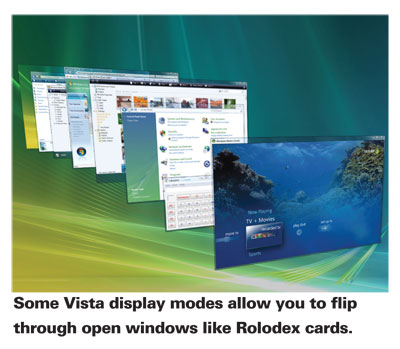Since many ophthalmic practices use the Windows operating system, they're probably already contemplating an upgrade to the latest Microsoft OS, Windows Vista. The new system offers some new features, but may also offer compatibility headaches with current software and may call for some pricey upgrades to your equipment. Here's a look at the new operating system.
The Operating System
Some of
• Enhanced security. "For a medical office's computer system, I think security is the most important thing," says
Another security feature

Since wireless networks are growing in popularity, Windows Vista offers updated wireless security protocols to allow users to connect to WiFi networks more securely. For example, a feature called Network Access Protection evaluates a computer that wants to access the network, to make sure it's secure.
• Data management. Julie Robertson, a spokesperson for Microsoft, says the new operating system helps users keep better track of their information. "With
• New user interface. Microsoft has jazzed up the user interface to the operating system, and has as an option the Aero interface, for PCs with enough graphics horsepower to handle its slick appearance.
Aero features a "Flip 3-D" feature, that creates thumbnails of all your open applications and documents so they look like Rolodex cards. Using an on-screen animation, you can then flip through each one to find the one you want. The updated Taskbar also makes use of the live thumbnails to give users another way to navigate through open documents and programs.
Proceed with Caution
Though Vista may offer some new features, some think it may be best to let the operating system mature before unleashing it upon your practice, especially if you've got everything humming along nicely with Windows XP.
Robert Meihoffer is the IT manager for Tri-County Eye Physicians and Surgeons in Southampton, Pa., and says he's given Vista a look, but isn't ready to jump on it yet.
"I'd never recommend for a business to upgrade to the next greatest operating system from Microsoft for at least six months," he says. "It always takes the company at least six months to get the bugs worked out.
"For example, a lot of the software that was designed for Windows XP may have problems working the way it was supposed to when used in Vista. Even when Internet Explorer 7.0 came out, when our practice made that upgrade we had problems with some of the websites we usually connect to not working with Explorer 7.0."
Mr. Meihoffer says this could also be a problem for ophthalmic-specific software like electronic medical records.
"Those programs' vendors may not have their software up to spec for working with
Then there are hardware issues. By all accounts,
Dr. Halpern is going to wait a while on



